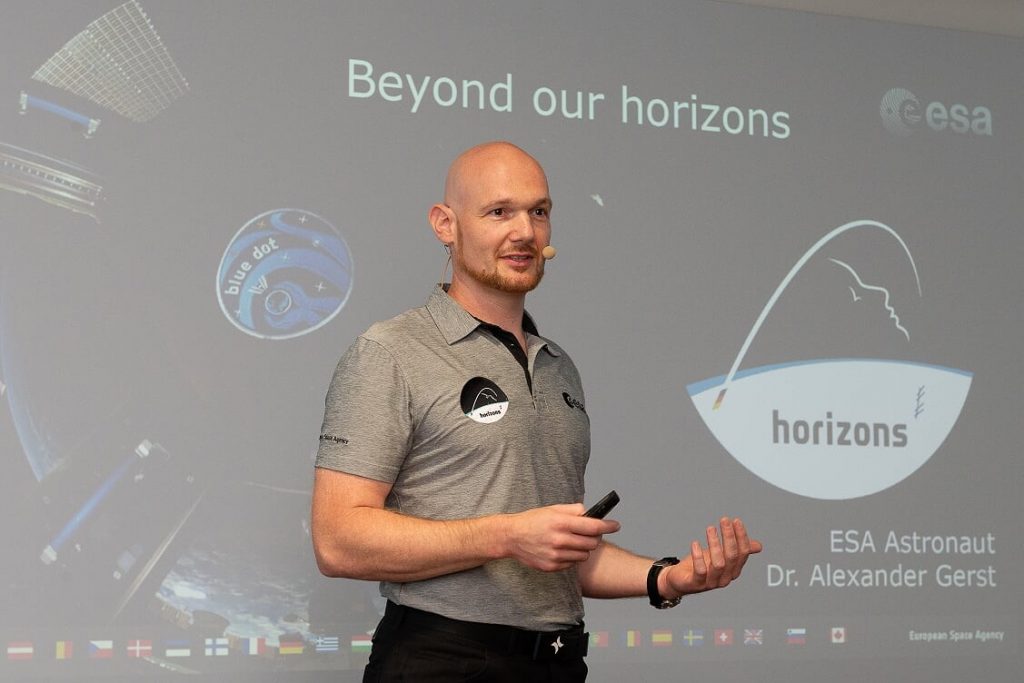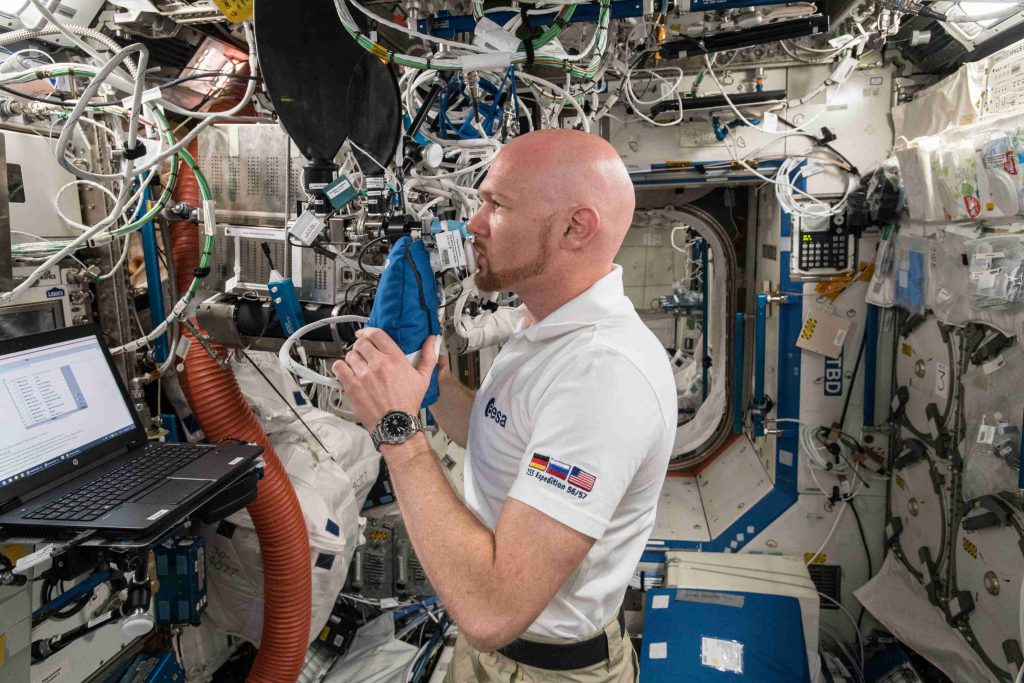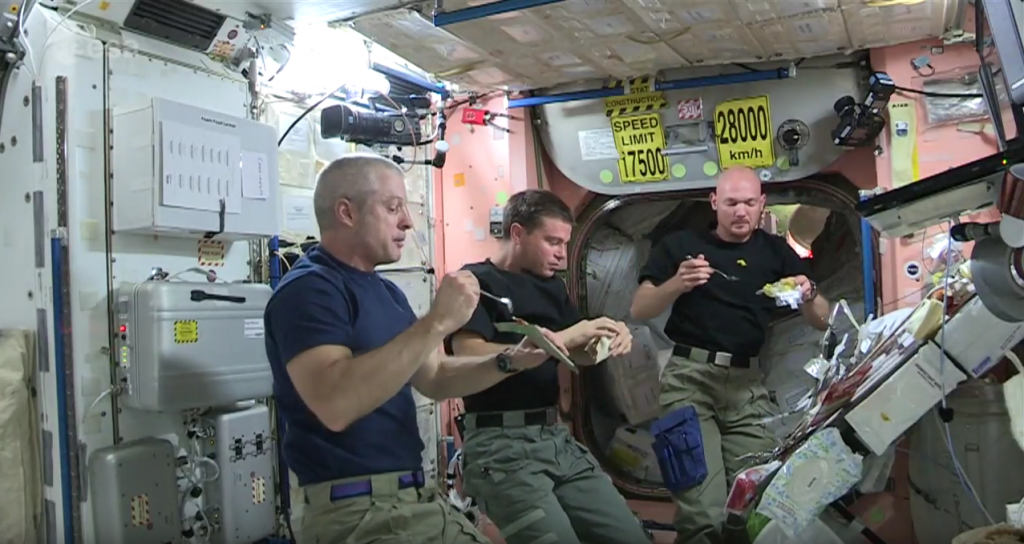Scientist in ESA’s Human Spaceflight programme Elizabeth Heider shares her experiences of a recent science debrief with ESA astronaut Alexander Gerst following the 2018 Horizons mission. The version below has been edited for length. See the full article on LinkedIn.
ESA astronaut Alexander Gerst’s 197-day Horizons mission finished just before Christmas on 20 December 2018. His Soyuz capsule skidded along the hot plasma of Earth’s upper atmosphere, heat shields reaching temperatures of 2500 degrees Celsius before the white and red parachute billowed behind it, setting it down on the snowy fields of Kazakhstan. The Russians call this a “soft landing”, but it was far from gentle as the crew absorbed an impulse equivalent to a gnarly car crash.
When the dust settled, Alexander felt the relentless grip of gravity pulling on his arms and legs, his head and neck. During his time on Station, he spent around 150 minutes a day exercising to maintain his muscles and skeleton. Gravity-bound, he had the strength to move himself, but his brain was unaccustomed to controlling a body suddenly so heavy. It was with fierce concentration that he instructed his body to climb free of the capsule, an experience he describes as “not fun”.
Half a year later, in a warm conference room at the German Space Agency (DLR) facility in Oberpfaffenhofen Germany, a robust and energetic Alexander stands in front of the group of scientists and operators who were his collaborators during those intense months. He wears a grey European Space Agency polo shirt with the Horizons mission patch. This is the science debrief of Alexander Gerst and it is a rare and fascinating experience.

ESA astronaut Alexander Gerst at science debrief following the Horizons mission. ESA-E.Heider.
The International Space Station was initially built as an international collaboration for exploration, a mission that has successfully demonstrated humankind’s ability to set aside political agendas to support an astounding vision. It is now is one of the most ambitious and successful international laboratories ever built – and the only microgravity laboratory in existence. To date, the ISS programme has involved 100 000 humans from 107 countries, supported 2800 experiments, and resulted in 1700 publications.
Alexander spent approximately 10 000 hours in training for his Space Station missions – first Blue Dot in 2014 and then Horizons in 2018. The Soyuz rockets he flew in were launched from the same launchpad used by Yuri Gagarin and he says liftoff is almost easy to miss. It takes just three minutes to get to space – 100 kilometres elevation. The rocket burns for another 5 minutes and 45 seconds. In the best-case scenario the Soyuz can reach the Station in three hours, but the fastest crewed flight at the moment takes around six and Alexander’s second journey took two days.
“You look out the window, and you see nothing,” Alexander tells us. “You launch into night.”
As the Soyuz flies into the daylight side of the Earth, the sunrise comes first as a blue streak – something you might initially mistake as a smudge on the glass.
“It’s embarrassing, but my first thought was: Wow. It’s round,” he admits.
Alexander’s next thought was also a realisation. “The atmosphere was thinner than I imagined. I wasn’t prepared for it. I only understood it once I saw it,” he says.
Orbiting Earth at a speed of 28 000 km and height of around 400 km, the International Space Station is an improbable dream. Alexander calls it the “most unlikely machine ever built”. Its unusual environment enabled the 371 total experiments conducted during Alexander’s time aboard the Station. And when considering why we perform science in space, Alexander likes to think about Richard Feynman, the Nobel-Prize winning particle physicist whose exceptional mind and exuberance for finding things out continues to fuel curiosity the world over. In Feynman’s words: “The thing that doesn’t fit is the thing that’s most interesting – the part that doesn’t go according to what you’d expect.”
The human physiology scientists present their results first, starting with Dr Lars Karlsson. Lars is the principal investigator for an experiment called Airway Monitoring that completed its run during Alexander’s mission. This experiment detects inflammation in the lungs using a measure of nitric oxide (NO) inhaled and exhaled by its subjects. The initial findings are fascinating, he tells us. The uptake of NO inhaled by crewmembers was higher in microgravity, due to greater absorption in the blood. This is important information as we prepare our next generation of astronauts to inhabit stations on the Moon, in deep space, and on Mars.

ESA astronaut Alexander Gerst participates in the Airways Monitoring experiment. ESA/NASA.
Next is professor Hans Christian-Gunga, and his experiment Circadian Rhythms, which measures the astronaut’s body temperature, activity and sleep cycle. The International Space Station is in low Earth orbit, completing one revolution of Earth every 90 minutes. As a result, crewmembers experience 16 sunrises and 16 sunsets each day. Surprisingly, the experiment found crew members kept a strict circadian rhythm in microgravity, this was just shifted. Also surprisingly, the overall temperature of the crew increased by about one degree. This result is exciting and strange to us – and to Alexander who wore the temperature monitor on his forehead and sternum for 36-hour periods. He jumps in to converse with the professor.
“Sleeping at night was a problem when we felt very warm,” he says. “On Saturday nights we also slept worse because we were eating with the Russians later in the day, nibbling some snacks. This made us hot the whole night. We thought something was wrong with the cooling system on Node 2.“

Eating in space. ESA/NASA.
“Temperature is closely tied to what you eat when, much more than on the ground. In space, I noticed that our skin was hotter than usual. But my body was getting rid of heat in a little different way. None of us had the feeling of having a warmer core.”
As Alexander speaks, we are right there with him, all of us weightless, blood pressure elevated in our faces, making us warm, making our ears ring. We nod. Yes – aren’t we hotter than usual? Aren’t we worried about the cooling system on Node 2? We are all relieved and interested to notice that this is because of the eating, not the temperature control.
Next, we hear about Myotones, where an astronaut’s muscle tone is tracked over the course of the mission, and about GRIP and GRASP, two experiments tracking how the brain adjusts to reach for objects and hold onto them without the vector of gravity to telling an astronaut’s body where they are.
Then there is a biology experiment, Molecular Muscle, trying to learn the mechanisms for muscle changes in space, before we turn to the physics payloads.

DOSIS-3D passive dosimeter on the International Space Station. ESA/A.Gerst.
A radiation detection experiment called DOSIS-3D uses materials with special properties to measure the amount of radiation exposure aboard the Station. There’s also a study of the behaviour of granular materials experiment called COMPGRAN.
A favourite of mine is the Electromagnetic Levitator (EML) laboratory which uses a solenoidal coil in a furnace to suspend small metal alloy samples and induce vibrations to measure properties such as surface tension and viscosity and specific heat capacity. The presenter is Dr Markus Mohr whose EML Experiment is called ThermoProp/Thermolab. The results of Markus’ experiment are exciting: a metal sphere 6.5 mm in diameter – an alloy comprised of Zirconium, Copper, Nickle, Titanium and Aluminium – is the first metallic glass produced in space.
After this comes the host of technical demonstrations: from Cimon, the free-floating artificial intelligence-equipped robot intended to provide practical and emotional assistance to long-term flight crews, to the Magvector payload that took a detailed survey of Earth’s magnetic field and the electromagnetic interaction with certain magnetic materials.
There is also the charismatic Dr Neal Lee whose humanoid robot Rollin’ Justin was given tasks to perform by crewmembers to test and improve the ability of humans and robots to interact to build habitats and support for life on the Moon and Mars.

Humanoid robot Rollin‘ Justin. DLR-R.Riedel
By the time the conference is nearing its end, we don’t want to leave. The daily work of scientists and ESA operations staff, engineers, managers, and planners can be taxing: intense, relentless, and sometimes painfully tedious. But it is only through the dedication of the entire group that these remarkable results can be achieved. Together, we sense the special connection.
On board the International Space Station, Alexander Gerst was the tip of the spear – his activities the culmination of years of painstaking effort by so many people. When you’re in the middle of the action, it’s difficult to glimpse or imagine any larger perspective. Now, together, we feel the pride and joy and satisfaction of seeing the loop closed and my realisation, as I view our work from such a perfect height is: “Wow. It’s round.”




Discussion: 3 comments
Finally with some time to relax and read this post. New teacher job at GPISD keeps me quite busy. Construction on the new home is challenging at Veridian Essence. Tree selection is complete. A long path with my final Ph.D. Dissertation stage coming up at Walden-U. But so happy to read your column. A blessing for a new life. Always in my prayers for a wonderful future. Hope
Interesting.
Good.